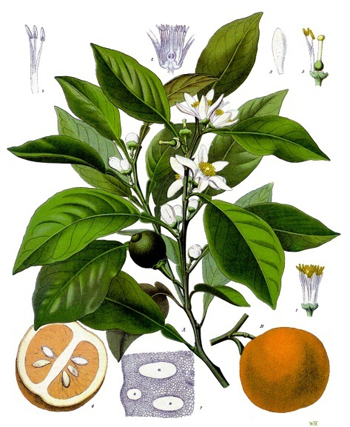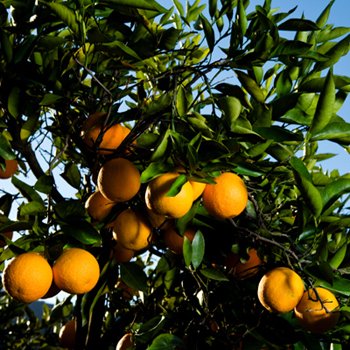Contents:
Common Names | Parts Usually Used | Plant(s) & Culture | Where Found | Medicinal Properties | Biochemical Information
Legends, Myths and Stories | Uses | Nutrient Content | How Sold | Warning | Bibliography
Scientific Names

- Citrus aurantium L.
- Poncirus trifolata
- Rutaceae
- Rue family
Common Names
- Seville orange
- Sour orange
Parts Usually Used
Flowers, rind of the fruit
Back to Top

Description of Plant(s) and Culture
The orange is an evergreen tree; the trunk is covered with smooth grayish-brown bark; with its branches, it reaches a height of 20-30 feet. Long spines appear beside the buds. The alternate, ovate-oblong leaves are glossy and dotted with glands; their petioles are broadly winged, their margins are sinuate or crenately toothed. One or more fragrant, white, five-petaled flowers grow in the leaf axils. The fruit is the familiar orange (technically an hesperidium), with segmented sour pulp inside a roughish rind. This species is not eaten fresh but is made into marmalade.
Other varieties: Sweet orange (C. sinensis) which is grown for eating, differs from the bitter orange in having narrowly winged petioles and few or no spines. The fruit is usually smaller and has a sweet taste. Medicinally it can be used like bitter orange, but is less effective except as a carminative.
Mandarin orange (C. reticulata) used medicinally much as the bitter orange.
Back to Top
Where Found
Native to Asia but has become common cultivated (as in Florida, California, etc.). Grown in the far north of the United States (Baltimore) as an ornamental.
Back to Top
Medicinal Properties
Carminative, expectorant, laxative, stimulant, stomachic, tonic
Back to Top
Biochemical Information
Neohesperidin, naringin, rhoifolin, lonicerin, vitamin C and flavonoids
Back to Top
Legends, Myths and Stories
The bitter orange rind is used in Vermouth flavorings. The oil or dried peel is used in many liqueurs and bitters.
Originating in southeast Asia or India, oranges are described in Chinese writings as early as 2200 BC, though their use is thought to date back much farther. The name orange is derived from the Sanskrit word for the fruit, narange. The bitter orange was introduced to Europe by the Crusaders; the sweet orange was not known in Europe until the 15th century, probably brought there from the Orient by Genoese merchants.
The Crusaders observed that Saracen brides wore orange blossom wreaths at their weddings. To the Saracens, the orange was a symbol of fecundity, because the tree bears fruit and blossoms at the same time. After the Crusaders’ return, the custom of using orange blossoms as bridal flowers was adopted in Europe; but it did not become widespread until the 17th century, probably because the blossoms were very rare and expensive until then.
The orange, as a traditional Chinese symbol of good luck and prosperity, is still used today in Chinese New Year’s celebrations.
Bitter orange was bred specially for the extraction of pharmaceutical drugs, primarily in the West Indies and Spain. The bitter orange is only distantly related to the citrus fruits we eat; oranges, tangerines, and grapefruits. The flowers, the small unripe fruits, and the peel, minus the white inner skin, are the parts used pharmaceutically. Flowers have a pleasant scent and ripe fruit contains sweet-smelling essential oil but bitter-tasting flavonoids.
Back to Top
Uses
The dried rind is helpful for dyspepsia and constipation. The oil derived from the fresh rind can be used to dispel flatulence; it makes a pleasant and nonirritating remedy for chronic bronchitis and lack of appetite. An infusion of dried flowers acts as a mild nervous stimulant, but the oil obtained by distillation of the flowers has hypnotic properties when inhaled.
Back to Top
Nutrient Content
Sweet orange: iron, phosphorus, magnesium, calcium, vitamins B1 and C
Back to Top
How Sold
Made into marmalades
Back to Top
Warning
Avoid citrus use if gastric or intestinal ulcers exist.
Back to Top
Bibliography
![]() The Complete Medicinal Herbal
The Complete Medicinal Herbal, by Penelope Ody, Dorling Kindersley, Inc, 232 Madison Avenue, New York, NY 10016, First American Edition, copyright 1993
![]() Back to Eden
Back to Eden, by Jethro Kloss; Back to Eden Publishing Co., Loma Linda, CA 92354, Original copyright 1939, revised edition 1994
 The Healing Plants
The Healing Plants, by Mannfried Pahlow, Barron’s Educational Series, Inc. 250 Wireless Blvd., Hauppauge, NY 11788, 1992
![]() The Herb Book
The Herb Book, by John Lust, Bantam Books, 666 Fifth Avenue, New York, NY. copyright 1974.
![]() The Nature Doctor: A Manual of Traditional and Complementary Medicine
The Nature Doctor: A Manual of Traditional and Complementary Medicine, by Dr. H.C.A. Vogel; Keats Publishing, Inc., 27 Pine Street (Box 876) New Canaan, CT. 06840-0876. Copyright Verlag A. Vogel, Teufen (AR) Switzerland 1952, 1991
 Old Ways Rediscovered
Old Ways Rediscovered, by Clarence Meyer, Meyerbooks, publisher, PO Box 427, Glenwood, Illinois 60425, published from 1954, print 1988
![]() Planetary Herbology
Planetary Herbology, by Michael Tierra, C.A., N.D., O.M.D., Lotus Press, PO Box 325, Twin Lakes. WI 53181., Copyright 1988, published 1992
![]() Webster’s New World Dictionary
Webster’s New World Dictionary, Third College Edition, Victoria Neufeldt, Editor in Chief, New World Dictionaries: A Division of Simon & Schuster, Inc., 15 Columbus Circle, New York, NY 10023
![]() The Yoga of Herbs: An Ayurvedic Guide to Herbal Medicine
The Yoga of Herbs: An Ayurvedic Guide to Herbal Medicine, by Dr. David Frawley & Dr. Vasant Lad, Lotus Press, Twin Lakes, Wisconsin, Second edition, 1988.
 The Rodale Herb Book: How to Use, Grow, and Buy Nature’s Miracle Plants (An Organic gardening and farming book)
The Rodale Herb Book: How to Use, Grow, and Buy Nature’s Miracle Plants (An Organic gardening and farming book), edited by William H. Hylton, Rodale Press, Inc. Emmaus, PA, 18049., 1974
